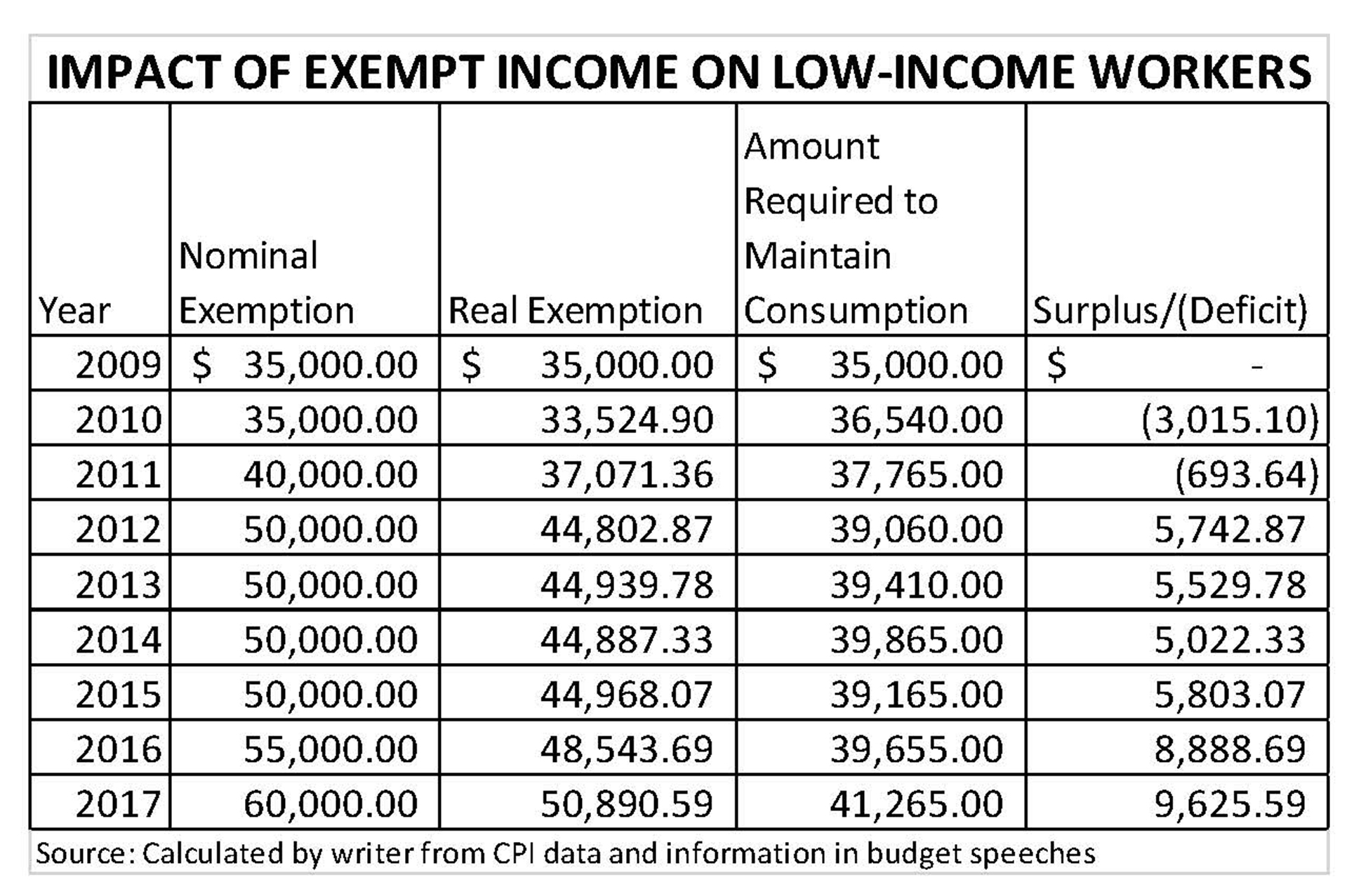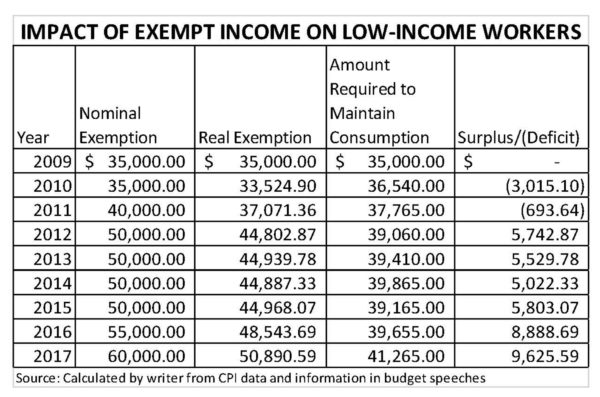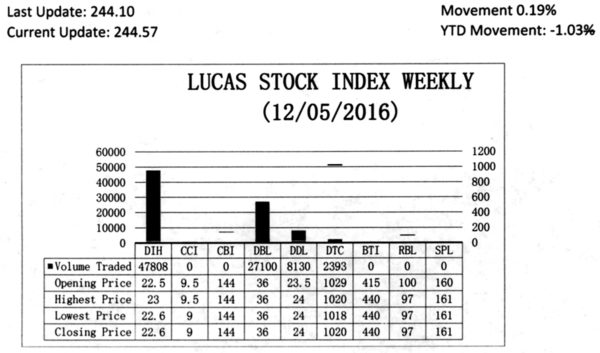Mutually beneficial
Last week, this writer began a discussion about the 2017 Budget that was presented by the government. As a financial plan, the government’s budget deals with revenues and expenses for the period under consideration. Revenues are important to the government and how it gets them is of interest to the taxpayers of this country simply because the taxpayers are involved. Taxation is the primary means by which government raises its revenues and it does so by turning to workers, entrepreneurs and companies. For the sake of social and economic progress, that relationship needs to be cooperative and mutually beneficial. It calls for an operating environment that enables every economic actor to get on with his or her daily life.
The government utilizes a group of taxes to get the amount of revenue that it is looking for from people and businesses. Collectively, these taxes are referred to as the tax structure. The mix of taxes making up the tax structure could be classified as direct and indirect taxes. It is important to understand the distinction between the direct tax and the indirect taxes. The direct taxes determine the amount of money that Guyanese have to spend and this spending money is also known as disposable income. On the other hand, the indirect taxes determine how many goods and services Guyanese could get with the spending money that they have. This latter issue is all up to the taxpayer, for he or she could decide if to spend the money or not. However, for money to be useful, it must be spent, which is when the issue of indirect taxes such as VAT steps in and becomes a matter of interest to the taxpayer. Nonetheless, the challenges that Guyanese and their businesses face all start with the direct taxes.
Principal direct tax
The principal direct tax is the income tax. It is referred to as a direct tax because it comes directly from the income that people obtain and from the profits of businesses. The tax proposals in the budget have different implications for individuals and businesses and as such the discussion will start with a focus on individuals and then move to businesses. For individuals, the income consists of two types, namely earned income and unearned income. The earned income refers to things like wages and salaries, commissions, and income earned by tributors, entertainers and other skilled persons for the work that they do. In other words, earned income comes from the performance of work by a taxpayer in exchange for money or some other kind of consideration. The unearned income refers to things like interest on bank deposits, discounts on Treasury Bills or any similar financial instrument, income from renting a building, gains on selling shares, dividends that come from companies that are not resident in Guyana and so on. In other words, unearned income comes primarily from investments. For both earned and unearned income, government makes use of the withholding techniques to get the taxes. For earned income, government utilizes the pay-as-you-earn (PAYE) system which guarantees that the taxes are removed before people get their hands on their money.
Consciously worry
One could see then that the tax of immediate concern is the income tax because it determines the amount of money anyone would have to spend each month or each pay period if that is the way one manages his or her money. People consciously worry about the amount of time they spend working and the money that they eventually take home for doing that work. This is not a theoretical issue. It is real and is linked to the attitude that people exhibit at work. In other words, it affects productivity and hence how much more money people actually are able to get by working. Like workers in other places, Guyanese wonder about the rationality of working an extra hour or an extra day and giving up leisure time or ‘quality time’ for what they might think is too little take-home pay or disposable income. This attitude is not unique to any category of worker and reflects itself in the urge for companies to seek benchmarks by which to compare the performance of their enterprises. They undertake salary surveys also to see if their compensation packages are competitive enough to retain staff. Because of its impact on disposable income, tax policy is not only fundamental to productivity, it is critical to maintaining a sustainable labour force. Therefore, government’s income tax policy should always be conscious of issues like labour force retention and motivation.
Desire for equity
In addition to issues of labour force retention and motivation, a major concern of the government is people’s ability to pay taxes. They need them to pay taxes but not to the extent where it destroys their ability to make ends meet. Government adjusts the pay of their workers accordingly, but the bulk of the workers are found in the private sector and government does not control wages in the private sector. However, the government controls the decision as to who can pay taxes from the income that they receive.
The government does this by deciding on the amount of income that will be exempted from taxes. Consequently, the concern does not start with how much a person can pay; it begins with whether or not the person could pay the tax in the first instance. Private sector workers do not have the ability to negotiate reasonable wages for themselves, but government helps them by increasing the amount of income that is exempted from taxes. The exemption therefore is not just a number.
It is an appreciation of the invaluable contribution that low-income workers make to the country’s economic welfare and enabling that contribution to be reflected in the money that they receive from their employers. Beyond that, it is about the dignity of workers and the control that they have over their lives.
The 2017 Budget reflects those sentiments. The current government has gone further than the previous administration by increasing the number of exemption thresholds and the amount of the exemption in each category, thereby reaffirming its desire to see positive changes in the lives of workers.
It has also adjusted the tax rate and added a new one. The two exemption thresholds and the two nominal tax rates reflect a desire for greater burden sharing in the allocation of economic resources between the government and the people through the ability-to-pay principle. In doing so, the Granger administration has made a conscious decision to reduce the proportionate burden that low-income workers were carrying and to shift it to the well-off. The government has decided to increase the exemption threshold from $55,000 in 2016 to $60,000 per month in 2017.
This move by the government has resulted in more money remaining in the hands of the low-income taxpayers and gives them greater flexibility to manage their lives.
Doubt about the positive impact of the direct tax policy of the current government and its reach beyond philosophical feelings about the poor is removed as can be seen from the data in the Table below. Table 1 contains data with a 2009 start year. The selection of that year was driven by the fact that the previous government used it as the new base year for the Consumer Price Index (CPI). In that year too, the government increased the exemption threshold to $35,000 suggesting that the choice of exemption amount was enough money to satisfy the needs of the poor.
TABLE 1
LUCAS STOCK INDEX
The Lucas Stock Index (LSI) rose 0.19 per cent during the first period of trading in December 2016. The stocks of four companies were traded with 85,431 shares changing hands. There were two Climbers and one Tumbler. The stocks of Banks DIH (DIH) rose 0.44 per cent on the sale of 47,808 shares. The stocks of Demerara Distillers Limited (DDL) rose 2.13 on the sale of 8,130 shares while the stocks of Demerara Tobacco Company (DTC) fell 0.87 per cent on the sale of 2,393 shares. In the meanwhile, the stocks of Demerara Bank Limited (DBL) remained unchanged on the sale of 27,100 shares.
The second column of the table shows the exemption threshold over time. The third column shows the value of goods and services that the exempted income could buy given changes in prices as reported in the CPI. The fourth column shows the amount of money needed each year to buy the same basket of goods that $35,000 could buy. The negative numbers in the final column show the amount of money that the poor had to borrow each month to buy the same amount of goods and services. The positive numbers show the value of the additional goods and services that they could buy.
Projections
It should be obvious that in 2010 and 2011, the poor, in order to survive, had to borrow in excess of $3,000 each month in 2010 and nearly $700 per month in 2011. Things improved from the period 2012 to 2014 when the exemption rose to $50,000 and they were able to buy an average of $5,400 worth of additional goods each month. When the Granger government took office and increased the exemption threshold to $55,000, low-income workers had the ability to buy in excess of $8,800 worth of goods and services. Projections as to what was likely to happen in 2017 indicate that the 2017 budget does not hurt the poor. It helps the poor. The question then is what is causing the low-income workers to complain? The answer to that and other questions will be provided in the next part of the article.
(To be continued)









